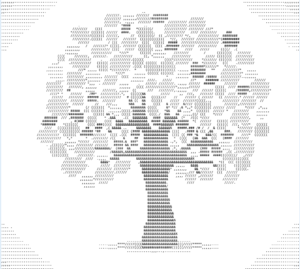ASCII art, sometimes referred to as ANSI art or text art, is the process of generating simple or complex imagery using computer text characters from the American Standard of Coded Information Interchange (ASCII) character set. The process involves creative placement of typed characters in order to create visual shapes or complex representations of people. They are usually spread over multiple lines of text. ASCII text art can be seen in email signatures, online game chats, comment sections, and online discussion forums.
While ASCII art may seem like a product of modern advancements in technology being brought about by the invention of computers, but this kind of text art actually predates the invention of computers by hundreds of years. In fact, text art has been used as far back as in the ancient Greece.
Let’s take a deeper look at ASCII art by looking through its history, its many examples, and how you can create your own ASCII art.
The History and Evolution of ASCII Art
Before text was used to form pictures, pictures were used in place of text to convey a message in the form of hieroglyphics in ancient Egypt. Over time the written word developed into symbols that more closely resembled modern text. The early versions of text art were hand-drawn. With creative use of ornamental penmanship people created beautiful documents and pictures. This was evident in the early manuscripts created by monastic monks.
The art of hand-drawn text art images continued even until the 1950s. One of the most prominent works of art during that time was a hand-drawn text picture of Jesus by Korean Gwang Hyuk Lee. Lee used the entire text in the Book of John to create this multi-colored image of Jesus.
The publishing of books became much faster with the invention of the printing press in Germany in the year 1450. A nice example of text art that came about in print was Lewis Caroll’s 1865 book Alice in Wonderland in which he arranged the text in Chapter III to form a mouse’s tail.
The invention of the typewriter was a welcome change in the world of text creation as it brought about a more personalized way of printing manuscripts. But it also became a new tool for creating art. An early testament to the new invention as an art medium was Flora F. F. Stacey’s creation of a butterfly made entirely of typewriter symbols. It was created by feeding the paper into the rollers from different and creative angles at different times.
Typewriter art became more popular from the 1950s up till the 1970s. Many are available in Alan Riddell’s book Typewriter Art. Robert Morgan created a piece of text art that bore the image of Henri Chopin, which was a design to be placed on the sleeve of Chopin’s record.
The invention of the computer gave rise to, perhaps, the golden era of ASCII art as it offered a tempting new way of passing on information visually. It was extensively used in some of the earliest computer games, such as maps for Star Trek (1971) and NetHack (1987). It gained even more prominence with the arrival of dial-up internet connections as people labored over their e-mail signatures as a way of creatively ending their messages. The early use of ASCII also included the very first ASCII emoticons to represent emotions visually through text.
Fast forward to the present when dial-up has been replaced with faster ways to connect to the internet and more advancements in technology have been introduced. We now have spectacular video games and better graphics and people just don’t seem to be messing around with ASCII art anymore. After all, why waste time on ASCII art when photo and video sharing has never been easier? However, even if that is the case, ASCII art still continues to be prominent and will continue to attract.
Related: A History of Chatbots
Creating Your Own ASCII Art
Maybe you weren’t aware of this, but ASCII art certainly doesn’t have to be sophisticated and the chances are that you’ve been creating your own pieces of ASCII art in the past. For example, take a look at these one-liner ASCII art pieces:
- ( T_T) – crying man
- t(‘.’ t ) – man putting up a fist or giving the dirty finger
- ( ^_^ ) – smiling man
- @>---^----- - a rose
If you want to create more sophisticated pieces of ASCII art from any image, then you can follow this guide:
- Choose an image you want to convert into ASCII art. It should be something that doesn’t have a background and doesn’t have too many small details.
- Open a word document and paste the chosen image into it.
- Right-click on the image and select Size and Position. Go to the Text Wrapping tab and select In Front of Text. Then go to the Position tab and uncheck the option that says Move object with text.
- Set the transparency of the image by clicking on the image and select Format under Picture tools on the toolbar. On the Adjust group select Color and choose Set Transparent Color. Click the part on the image that you want to make transparent.
- Change the brightness of the photo to 70 and the color to gray if it is colored.
- To begin your artwork set the font face to Courier New and the font size to 12. Type over the image line for line. Use the space bar for negative spaces. For lightly colored areas use ! or l. For light-colored areas use C, E, or F and M and W for dark-colored areas. Lastly, use (, ), V, A, Y, d, b, /, \, and so on for the edges. Match the image as you type the characters.
- When you’re done, remove the image and save the file. Copy and paste the ASCII image you’ve created when you need to use it or simply take a screenshot.
Now you know the long way to creating your very own ASCII art. However, if you prefer a shorter, easier way, you can simply choose any application that converts any image into text. But the long version is way cooler, and much more rewarding.





